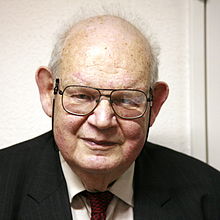
Born: 20 November 1924, Warsaw, Poland
Died: 14 October 2010, Cambridge, Massachusetts, United States
Early days. Mandelbrot’s mother was a dental surgeon, his father traded clothing. He was first introduced to mathematics by two of his uncles, one of whom, Szolem Mandelbrojt, was a mathematician residing in Paris. Anticipating the threat posed by Nazi Germany, the family fled from Poland to France in 1936. Mandelbrot attended the Lycée Rolin in Paris until the start of World War II, when his family then moved to Tulle, France. He was helped by David Feuerwerker the Rabbi of Brive-la-Gaillarde, to continue his studies. Much of France was occupied by the Nazis at the time, and Mandelbrot recalls this period: ”Our constant fear was that a sufficiently determined foe might report us to an authority and we would be sent to our deaths. This happened to a close friend from Paris, Zina Morhange, a physician in a nearby county seat. Simply to eliminate the competition, another physician denounced her.... We escaped this fate. Who knows why?” In 1944 Mandelbrot returned to Paris, studied at the Lycée du Parc in Lyon, and in 1945 to 1947 attended the École Polytechnique. From 1947 to 1949 he studied at California Institute of Technology, where he earned a master's degree in aeronautics. Returning to France, he obtained his Doctorate in Mathematical Sciences at the University of Paris in 1952.
Career. He spent most of his career in both the U.S. and France, having dual French and American citizenship. From 1949 to 1958 Mandelbrot was a staff member at the Centre National de la Recherche Scientifique. From 1951 onward, Mandelbrot worked on problems and published papers not only in mathematics but in applied fields such as information theory, economics, and fluid dynamics. In 1955 he moved to Geneva, Switzerland, and later to the Université Lille Nord de France. In 1958 Mandelbrot joined the research staff at the IBM Thomas J. Watson Research Center in Yorktown Heights, New York. He remained at IBM for 35 years, becoming an IBM Fellow, and later Fellow Emeritus. Because of his access to IBM's computers, Mandelbrot was one of the first to use computer graphics to create and display fractal geometric images, leading to his discovering the Mandelbrot set in 1979. In so doing, he was able to show how visual complexity can be created from simple rules. He said that things typically considered to be "rough", a "mess" or "chaotic", like clouds or shorelines, actually had a "degree of order". In 1982, Mandelbrot expanded and updated his ideas in The Fractal Geometry of Nature. Mandelbrot left IBM in 1987 when IBM decided to end pure research in his division. He joined the Department of Mathematics at Yale, and obtained his first tenured post in 1999, at the age of 75. At the time of his retirement in 2005, he was Sterling Professor of Mathematical Sciences at Yale University. Mandelbrot also held positions at the Pacific Northwest National Laboratory, Université Lille Nord de France, Institute for Advanced Study and Centre National de la Recherche Scientifique. His autobiography, The Fractalist, was published in 2012.
Personal. He is survived by his wife (they were married in 1955), Aliette Mandelbrot of Cambridge, Massachusetts; two sons, Laurent Mandelbrot of Paris, France, and Didier Mandelbrot of Newton, Massachusetts; and three grandchildren.
Awards and honors
• American Mathematical Society Einstein Lectureship (2006)
• A small asteroid named 27500 Mandelbrot
• Barnard Medal
• Best Business Book of the Year Award (2004)
• Caltech Service
• Casimir Funk Natural Sciences Award
• Charles Proteus Steinmetz Medal
• Franklin Medal
• Harvey Prize (1989)
• Honda Prize
• Humboldt Preis
• Fellow, American Geophysical Union
• IBM Fellowship
• Japan Prize (2003)
• John Scott Award
• Knight of the Légion d'honneur (Legion of Honour) (1990)
• Lewis Fry Richardson Medal (2000)
• Medaglia della Presidenza della Repubblica Italiana
• Médaille de Vermeil de la Ville de Paris
• Nevada Prize
• Member of the Norwegian Academy of Science and Letters.
• Officer of the Légion d'honneur (2006)
• Science for Art
• Sven Berggren-Priset
• Władysław Orlicz Prize
• Wolf Foundation Prize for Physics (1993)
• 15 honorary doctorates
This article uses, among others, material from the Wikipedia article "Benoit Mandelbrot." Text is available under the Creative Commons Attribution-ShareAlike License; additional terms may apply.:
Benoit Mandelbrot
Other sources include:
NNDB
Encyclopedia Britannica
Return to home page:
Prominent Poles